ignition Citroen C5 2017 (RD/TD) / 2.G Service Manual
[x] Cancel search | Manufacturer: CITROEN, Model Year: 2017, Model line: C5, Model: Citroen C5 2017 (RD/TD) / 2.GPages: 348, PDF Size: 10.72 MB
Page 126 of 348
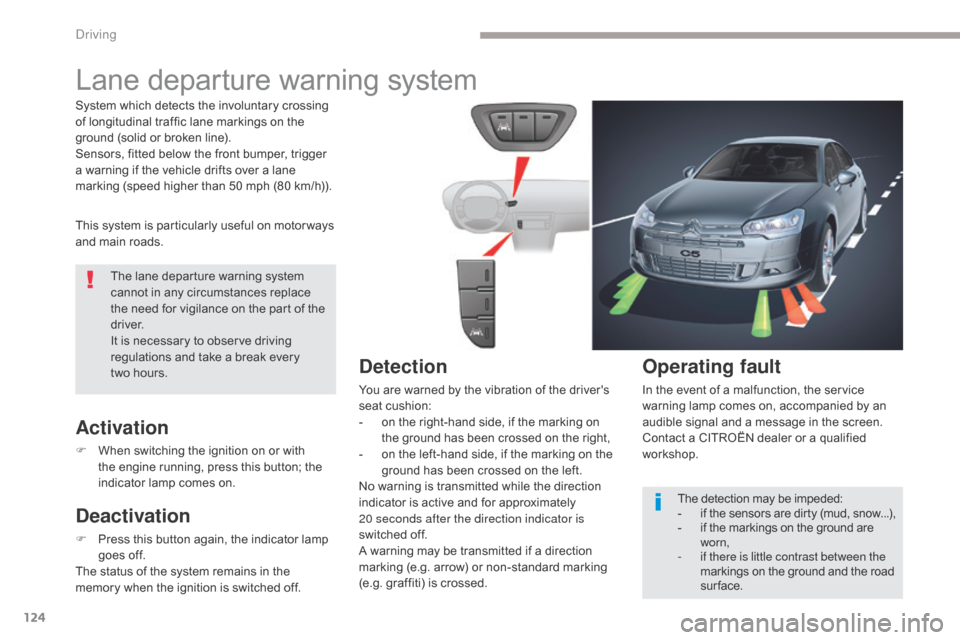
124
C5_en_Chap04_conduite_ed01-2016
Lane departure warning system
This system is particularly useful on motor ways
and main roads.
Activation
F When switching the ignition on or with the engine running, press this button; the
indicator lamp comes on.
Deactivation
F Press this button again, the indicator lamp goes off.
The status of the system remains in the
memory when the ignition is switched off.
Detection
You are warned by the vibration of the driver's
seat cushion:
-
o
n the right-hand side, if the marking on
the ground has been crossed on the right,
-
o
n the left-hand side, if the marking on the
ground has been crossed on the left.
No warning is transmitted while the direction
indicator is active and for approximately
20
seconds after the direction indicator is
switched off.
A warning may be transmitted if a direction
marking (e.g. arrow) or non-standard marking
(e.g. graffiti) is crossed.
Operating fault
In the event of a malfunction, the service
warning lamp comes on, accompanied by an
audible signal and a message in the screen.
Contact a CITROËN dealer or a qualified
workshop.
System which detects the involuntary crossing
of longitudinal traffic lane markings on the
ground (solid or broken line).
Sensors, fitted below the front bumper, trigger
a warning if the vehicle drifts over a lane
marking (speed higher than 50 mph (80 km/h)).
The detection may be impeded:
-
i
f the sensors are dirty (mud, snow...),
-
i
f the markings on the ground are
worn,
-
i
f there is little contrast between the
markings on the ground and the road
sur face.
The lane departure warning system
cannot in any circumstances replace
the need for vigilance on the part of the
driver.
It is necessary to observe driving
regulations and take a break every
two
hours.
Driving
Page 128 of 348
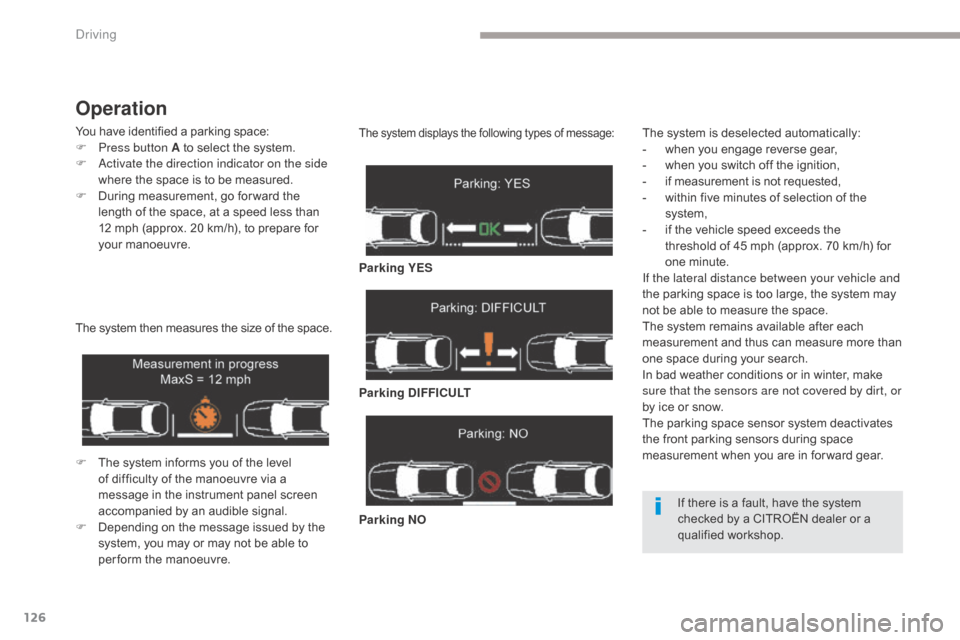
126
C5_en_Chap04_conduite_ed01-2016
Operation
You have identified a parking space:
F P ress button A to select the system.
F
A
ctivate the direction indicator on the side
where the space is to be measured.
F
D
uring measurement, go for ward the
length of the space, at a speed less than
12 mph (approx. 20 km/h), to prepare for
your manoeuvre.
The system then measures the size of the space.
F
T
he system informs you of the level
of difficulty of the manoeuvre via a
message in the instrument panel screen
accompanied by an audible signal.
F
D
epending on the message issued by the
system, you may or may not be able to
per form the manoeuvre.The system displays the following types of message:
Parking YES
Parking DIFFICULT
Parking NO The system is deselected automatically:
-
w
hen you engage reverse gear,
-
w
hen you switch off the ignition,
-
i
f measurement is not requested,
-
w
ithin five minutes of selection of the
system,
-
i
f the vehicle speed exceeds the
threshold of 45 mph (approx. 70 km/h) for
one minute.
If the lateral distance between your vehicle and
the parking space is too large, the system may
not be able to measure the space.
The system remains available after each
measurement and thus can measure more than
one space during your search.
In bad weather conditions or in winter, make
sure that the sensors are not covered by dirt, or
by ice or snow.
The parking space sensor system deactivates
the front parking sensors during space
measurement when you are in for ward gear.
If there is a fault, have the system
checked by a CITROËN dealer or a
qualified workshop.
Driving
Page 133 of 348
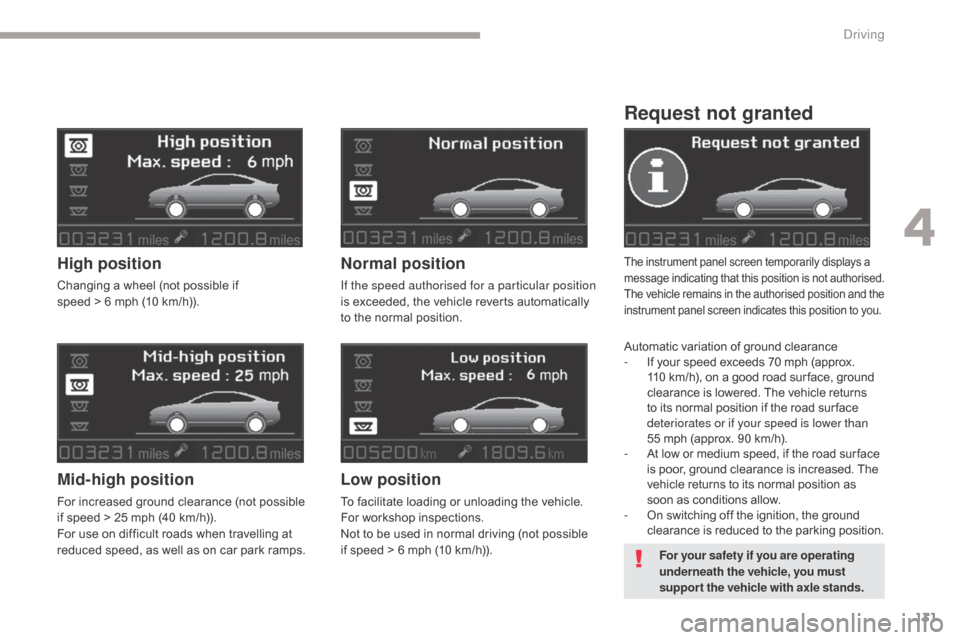
131
C5_en_Chap04_conduite_ed01-2016
Request not granted
The instrument panel screen temporarily displays a
message indicating that this position is not authorised.
The vehicle remains in the authorised position and the
instrument panel screen indicates this position to you.
Automatic variation of ground clearance
- If your speed exceeds 70 mph (approx.
110 km/h), on a good road sur face, ground
clearance is lowered. The vehicle returns
to its normal position if the road sur face
deteriorates or if your speed is lower than
55 mph (approx. 90 km/h).
-
A
t low or medium speed, if the road sur face
is poor, ground clearance is increased. The
vehicle returns to its normal position as
soon as conditions allow.
-
O
n switching off the ignition, the ground
clearance is reduced to the parking position.
Normal position
If the speed authorised for a particular position
is exceeded, the vehicle reverts automatically
to the normal position.
Low position
To facilitate loading or unloading the vehicle.
For workshop inspections.
Not to be used in normal driving (not possible
if speed > 6 mph (10
km/h)).
High position
Changing a wheel (not possible if
speed > 6 mph (10 km/h)).
Mid-high position
For increased ground clearance (not possible
if speed > 25 mph (40 km/h)).
For use on difficult roads when travelling at
reduced speed, as well as on car park ramps.
For your safety if you are operating
underneath the vehicle, you must
suppor t the vehicle with axle stands.
4
Driving
Page 135 of 348

133
C5_en_Chap05_eclairage-et-visibilite_ed01-2016
Manual controls
Lighting off (ignition off) /
Daytime running lamps (engine running).
Automatic illumination of headlamps.
Sidelamps.Dipped headlamps or main
beam headlamps.
B.
S
talk for switching headlamps: pull
the stalk towards you to switch the
lighting between dipped and main beam
headlamps.
In the lamps off and sidelamps modes, the
driver can switch on the main beam headlamps
temporarily ("headlamp flash") by maintaining a
pull on the stalk.
Displays
The lighting is controlled directly by the driver
by means of the ring A and the stalk B .A.
M
ain lighting mode selection ring: turn it
to position the symbol required facing the
mark.
C. Foglamps selection ring.
The foglamps operate with the sidelamps and
the dipped and main beam headlamps. Illumination of the corresponding indicator
lamp in the instrument panel confirms that the
lighting selected is on.
5
Lighting and visibility
Page 136 of 348
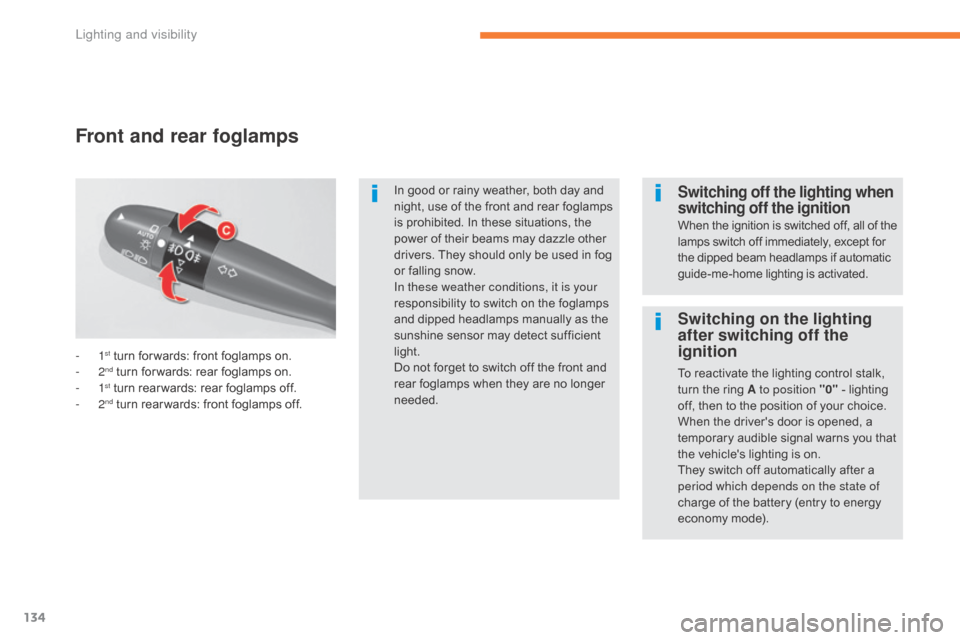
134
C5_en_Chap05_eclairage-et-visibilite_ed01-2016
- 1st turn for wards: front foglamps on.
-
2nd turn for wards: rear foglamps on.
-
1st turn rear wards: rear foglamps off.
-
2nd turn rear wards: front foglamps off.
Front and rear foglamps
In good or rainy weather, both day and
night, use of the front and rear foglamps
is prohibited. In these situations, the
power of their beams may dazzle other
drivers. They should only be used in fog
or falling snow.
In these weather conditions, it is your
responsibility to switch on the foglamps
and dipped headlamps manually as the
sunshine sensor may detect sufficient
light.
Do not forget to switch off the front and
rear foglamps when they are no longer
needed.Switching off the lighting when
switching off the ignition
When the ignition is switched off, all of the
lamps switch off immediately, except for
the dipped beam headlamps if automatic
guide-me-home lighting is activated.
Switching on the lighting
after switching off the
ignition
To reactivate the lighting control stalk,
turn the ring A to position "0" - lighting
off, then to the position of your choice.
When the driver's door is opened, a
temporary audible signal warns you that
the vehicle's lighting is on.
They switch off automatically after a
period which depends on the state of
charge of the battery (entry to energy
economy mode).
Lighting and visibility
Page 137 of 348

135
C5_en_Chap05_eclairage-et-visibilite_ed01-2016
Daytime running lampsManual guide-me-home
lighting
Switching on
F With the ignition off, "flash" the headlamps
using the lighting stalk.
F
A f
urther "headlamp flash" switches the
function off.
Switching off
The manual guide-me-home lighting switches
off automatically after a set time.
These special lamps, located at the front, make
the vehicle more visible by day.
The temporary illumination of the dipped beam
headlamps after the vehicle's ignition has been
switched off makes the driver's exit easier
when the light is poor.
They come on automatically and stay on, when
the engine is running and when the lighting
control stalk is at position 0 or AUTO
.
5
Lighting and visibility
Page 141 of 348

139
C5_en_Chap05_eclairage-et-visibilite_ed01-2016
Operating fault
If a fault occurs, this warning lamp
flashes in the instrument panel,
accompanied by a message in the
display screen.
"Directional headlamps" function
with directional lighting
without directional lighting
The state of the function remains in the
memory when the ignition is switched off.
When stationary or moving at very low
speed or when reverse gear is engaged,
the function is inactive. Contact a CITROËN dealer or a qualified
workshop.
Programming
The function is activated or deactivated via the
vehicle parameters menu.
This function is activated by default. When the dipped or main beam headlamps
are on, this function, associated with the
"Cornering lighting" function, enables the light
beam to follow the direction of the road.
The use of this function, linked with the xenon
headlamps only, considerably improves the
quality of your lighting when cornering.
5
Lighting and visibility
Page 144 of 348
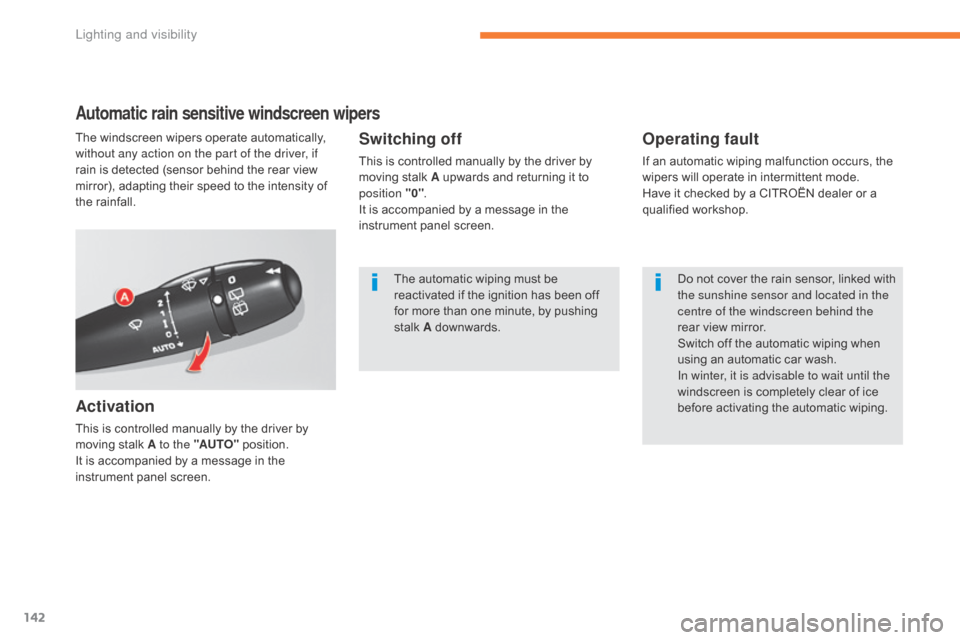
142
C5_en_Chap05_eclairage-et-visibilite_ed01-2016
Automatic rain sensitive windscreen wipers
Activation
This is controlled manually by the driver by
moving stalk A to the "AUTO" position.
It is accompanied by a message in the
instrument panel screen.
Switching off
This is controlled manually by the driver by
moving stalk A upwards and returning it to
position "0" .
It is accompanied by a message in the
instrument panel screen.
Operating fault
If an automatic wiping malfunction occurs, the
wipers will operate in intermittent mode.
Have it checked by a CITROËN dealer or a
qualified workshop.
The windscreen wipers operate automatically,
without any action on the part of the driver, if
rain is detected (sensor behind the rear view
mirror), adapting their speed to the intensity of
the rainfall.
Do not cover the rain sensor, linked with
the sunshine sensor and located in the
centre of the windscreen behind the
rear view mirror.
Switch off the automatic wiping when
using an automatic car wash.
In winter, it is advisable to wait until the
windscreen is completely clear of ice
before activating the automatic wiping.
The automatic wiping must be
reactivated if the ignition has been off
for more than one minute, by pushing
stalk A downwards.
Lighting and visibility
Page 145 of 348
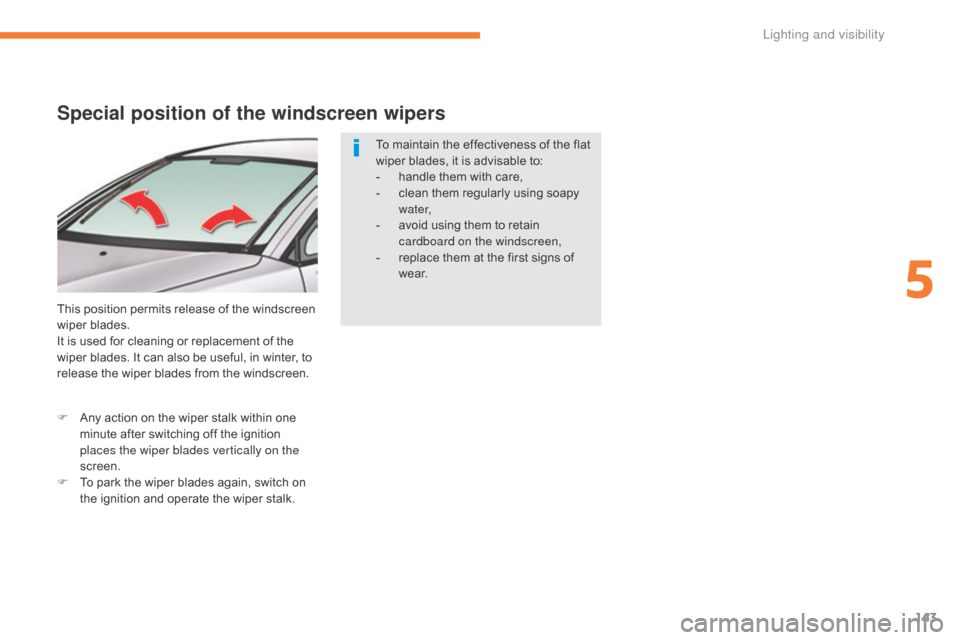
143
C5_en_Chap05_eclairage-et-visibilite_ed01-2016
Special position of the windscreen wipers
This position permits release of the windscreen
wiper blades.
It is used for cleaning or replacement of the
wiper blades. It can also be useful, in winter, to
release the wiper blades from the windscreen.
F
A
ny action on the wiper stalk within one
minute after switching off the ignition
places the wiper blades vertically on the
screen.
F
T
o park the wiper blades again, switch on
the ignition and operate the wiper stalk. To maintain the effectiveness of the flat
wiper blades, it is advisable to:
-
h
andle them with care,
-
c
lean them regularly using soapy
water,
-
a
void using them to retain
cardboard on the windscreen,
-
r
eplace them at the first signs of
w e a r.
5
Lighting and visibility
Page 147 of 348
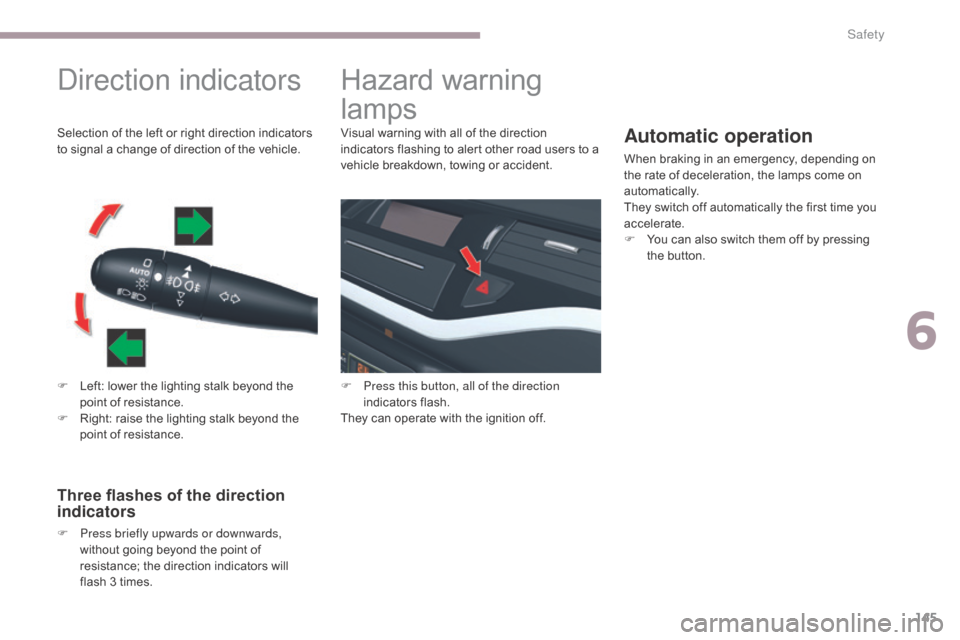
145
C5_en_Chap06_securite_ed01-2016
Direction indicators
F Left: lower the lighting stalk beyond the point of resistance.
F
R
ight: raise the lighting stalk beyond the
point of resistance.
Three flashes of the direction
indicators
F Press briefly upwards or downwards, without going beyond the point of
resistance; the direction indicators will
flash 3 times.
Hazard warning
lamps
Visual warning with all of the direction
indicators flashing to alert other road users to a
vehicle breakdown, towing or accident.Automatic operation
When braking in an emergency, depending on
the rate of deceleration, the lamps come on
automatically.
They switch off automatically the first time you
accelerate.
F
Y
ou can also switch them off by pressing
the button.
Selection of the left or right direction indicators
to signal a change of direction of the vehicle.
F
P
ress this button, all of the direction
indicators flash.
They can operate with the ignition off.
6
Safety